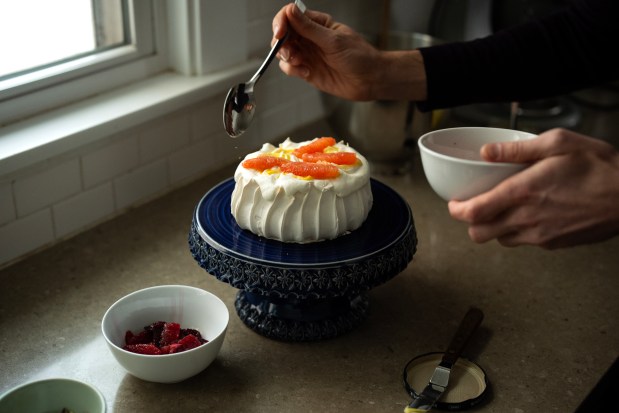As a baker, I relish making a Valentine’s Day dessert. Instinct says to seduce with a decadent chocolate treat, but sadly, my Valentine for the past 20 years isn’t the biggest chocolate lover. But I found a way to his heart: a pavlova.
This meringue-based dessert was named after Russian ballerina Anna Pavlova over a century ago. It’s enchantingly messy, with a shattering, melting outer crust yielding to a soft, marshmallow-like center. To complement the lean, sweet meringue, add a pile of whipped cream, a dribble of tangy lemon curd, a shower of fresh, juicy fruit and maybe some chopped nuts to sink your teeth into. (Oh, and it happens to be gluten-free.)
Pavlova is a classic dessert in Australia and New Zealand, but I won’t argue about where it originated. Instead, I asked my Melbourne-based baking buddy Adam Miller, a finalist on the “Great Australian Bake Off,” his thoughts. “It’s one of Australia’s most iconic desserts.” he said, “Especially in summer. Even more so at Christmas time. You’ll struggle to find a Christmas dessert table across the country that doesn’t feature a glorious pavlova, smothered with whipped cream and bejeweled with seasonal fruits.”
Since the Aussies whip up pavlova this time of year, you should try your hand at one to channel some of their antipodean summers. It provides the perfect ray of sunshine during our long winter. Our groceries are full of glorious winter citrus, which adds brightness to this ethereal dessert, which is bound to entice your Valentine.
Pavlova
This light, airy meringue relies on egg whites and sugar to achieve billowy peaks. The key is to use superfine sugar to ensure the sugar is fully dissolved, as regular granulated sugar is a challenge to dissolve.
Prep time: About 15 minutes active time, 70 minutes baking, and at least 2 hours cooling time.
Yield: 6-inch pavlova, which is two to four servings.
Ingredients:
100 g (1/2 cup) superfine sugar
1 wedge of lemon
2 large fresh egg whites (save the yolks for the lemon curd)
Pinch of fine sea salt
1 teaspoon corn starch
1/2 teaspoon lemon juice (from the lemon wedge)
1/2 teaspoon vanilla extract
Directions:
1. Put the granulated sugar into a blender or food processor and pulse until finely ground, almost powdery, if you don’t have superfine sugar. This helps the sugar dissolve more easily into the egg whites.
2. Heat oven to 250 degrees Fahrenheit with a rack in the middle of the oven.
3. Rub the inside of a clean stand mixer bowl with the cut side of the lemon wedge. Add the salt and egg whites, fit the mixer with a whisk attachment, and turn it to medium speed (6 on a KitchenAid). When the egg whites look like a frothy bath (just before soft peaks), about 1 minute, spoon in the sugar, one heaping teaspoon at a time, while the mixer is running. After adding all of the sugar, pause the mixer and scrape down any sugar stuck to the side of the bowl and the whisk. Keep mixing at medium until the sugar is dissolved — that’s the most important thing. Stop the mixer every minute or so and rub the meringue between your fingers. If you feel any sugar granules at all, keep mixing. This usually takes 5 to 7 minutes, but it all depends on your mixer and the size of the sugar granules.
4. Stop the mixer once the sugar has dissolved, and sift the cornstarch on top, then turn the mixer on medium speed and mix until the cornstarch is thoroughly mixed in. Stop the mixer, scrape the sides of the bowl, and add the lemon juice and vanilla, then turn the mixer on to medium speed and mix until combined. Check to see that you have barely stiff peaks by lifting the whisk out of the meringue, then flip it upside down. The meringue should have peaks that point straight up or curl just slightly, like the top of a soft-serve ice cream cone. If your meringue isn’t quite there, turn the mixer to medium-high and whip until you get those peaks.
5. Use a flat cookie sheet (without edges or rims) or turn a regular baking sheet upside down. This makes it much easier to remove the fragile pavlova. Cut a piece of parchment to fit the baking sheet. Draw a circle with a 5- to 6-inch diameter on one side of the parchment. Dab a bit of the meringue on all four corners of the baking sheet, then place the parchment paper on the baking sheet. (The meringue dabs act as a glue to keep the parchment in place when you spread the meringue.)
6. Dollop the meringue onto the circle in a tall mound, almost like a column. Using a small offset spatula or spoon, gently push the meringue down to match the circle you drew. Then, take your offset spatula or a butter knife and go around the edge of the pavlova to create nice, straight, even sides. Put the tip of the spatula (or the tip of a spoon) on the bottom of the outer edge of the pavlova and pull upward, creating an indentation in the pavlova with a bit of a peak on top. Go around the entire pavlova to give it this fun pattern.
7. Put the pavlova into the preheated oven carefully. Bake at 250 degrees Fahrenheit for 10 minutes. Turn the oven down to 200 degrees Fahrenheit and bake for 60 minutes more. Turn off the oven. Allow the pavlova to cool completely in the oven — at least 2 hours with the door closed. Cooling completely in a closed oven will prevent it from cracking too much. You can make this ahead a day or two in dry conditions, but be sure to keep it airtight, either sealed with plastic wrap or in an airtight container.
Note: It’s hard to make pavlova on a very humid or rainy day. If you’re somewhere very humid, a different dessert might be a better bet.
You can make the pavlova base one day before serving. Store in an airtight container somewhere dry and dark.
Lemon curd
Everyone should know how to make lemon curd. This tangy, creamy spread adds some tartness to this pavlova. You can also spread it on a biscuit, swirl it into your morning yogurt, use it as a cake filling — or just eat it with a spoon.
Prep time: 15 to 20 minutes
Yield: 1 small jar (about 1 1/2 cups)
Ingredients:
1 medium lemon
75 g (1/4 cup and 2 tablespoons) sugar
Pinch of salt
Pinch of ground turmeric (optional, but amps up the golden color)
1 large egg and 2 egg yolks
56 g (4 tablespoons) butter, cubed
1. Zest the lemon into a small saucepan and add the sugar. Rub the zest into the sugar with your fingers. Juice the lemon.
2. Add the salt, turmeric, egg and yolks, and lemon juice to the saucepan with the zesty sugar and whisk to combine.
3. Cook on low heat for 5 to 6 minutes while stirring with a heat-proof spatula until the curd feels very warm. Then, turn the heat up to medium-low and cook, stirring constantly, until it thickens and reads 170 degrees Fahrenheit on an instant-read thermometer, about 4 to 5 more minutes.
4. Add the cubed butter and stir until the butter has melted and emulsified into the curd.
5. Push the curd through a fine mesh strainer, put it into a jar and refrigerate until needed. The curd will keep in the refrigerator for about 2 weeks.
Whipped cream, garnishes and assembly
Prep time: About 10 minutes
Ingredients:
120 g (1/2 cup) heavy cream, cold
1 to 2 blood oranges, navel oranges or grapefruit
3 tablespoons chopped pistachios or almonds

Directions:
1. Whip the cream at medium-high speed until soft peaks form using a stand or hand mixer.
2. Slice the top and bottom off the orange or grapefruit. Set the fruit on one of the flat sides, then, using a very sharp knife, slice off the rind and all of the white pith, revealing the flesh.
3. Use the knife to go in between the membranes to remove the orange segments, and place them in a bowl.
4. Just before serving (I mean it: don’t top it until everyone is ready to eat) put the pavlova on a serving plate. Top the pavlova with the whipped cream, then dollop about 4 tablespoons of lemon curd on the cream and gently swirl it with a spoon
5. Garnish with citrus segments and sprinkle with chopped nuts.
6. Serve immediately.
Martin Sorge is a freelance writer.





